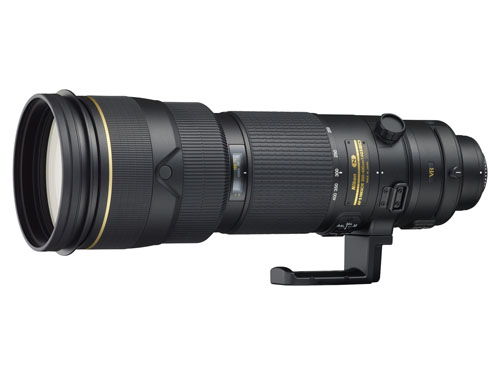Nikon AF-S Nikkor 200-400mm f/4 G ED VRII
 |
| Priced at £6200, Nikon's latest super-telephoto zoom is a serious bit of kit, with a serious price tag. |
Nikon's 200-400mm f/4 is currently one of a kind. No other manufacturer currently offers a zoom covering this range with a constant bright aperture of f/4. On top of that Nikon have equipped the lens with it's latest Vibration Reduction system, which promises to allow sharp shots to be obtained hand-held at shutter speeds up to four stops slower than without. Nikon Nano crystal coating has been applied, which promises to reduce ghosting, flare and to improve contrast. Other than that a new focus priority mode has been added, which gives preference to autofocus, even when the manual adjustment ring is being handled.
Priced at £6200, this lens is a professional tool suitable for sports and action and with the older version still available for around £4660, the new version has a lot to live up to.
Nikon AF-S Nikkor 200-400mm f/4 G ED VRII: Handling and features
Weighing in at over 3Kg, it's not the kind of lens you will want to be carrying around if you aren't dead serious about using it. At 365.5mm long without the hood attached, it's the kind of lens you mount a camera on, rather than the other way around. Luckily the lens is supplied with an excellent padded shoulder case, that will also accommodate a camera body attached. Hand holding this optic for long periods of time can be quite tiring due to the weight, but I found the handling and balance to be excellent with my D700 and MB-D10 attached. The zoom ring is pretty much bang on the centre of gravity, which helps with the good sense of balance. A sturdy non-removeable support bracket allows the lens to be securely attached to a monopod or tripod, which I would definitely recommend if using the lens for long periods of time.
This lens' build quality is second to none, with much of the lens barrel being constructed from lightweight magnesium and weather-sealed to be able to withstand the elements. Metal loops are provided either side of the tripod collar for carrying the lens in use, so that the camera's lens mount isn't under strain from the weight of the lens. The impressive build is reassuring enough that you wouldn't hesitate to carry if from your shoulder in this way. A removable glass protector also comes supplied screwed into the front filter thread. The protector itself has a large rubber bumper fitted around it's perimeter to protect the optics from impact. 52mm filters can be dropped into the lens towards the rear, such as a circular polariser and as this filter completes the optical formula, it is best left in place.
Auto focus is lighting quick and certainly up to the job of tracking erratic fast-moving subjects. Overall I found the lens a joy to use.
Nikon AF-S Nikkor 200-400mm f/4 G ED VRII: Performance
Unsurprisingly Nikon's 200-400mm produces good resolution from wide open right through the zoom range, at least in the centre of the image anyway.
At 200mm the lens performs well from wide open, with good resolution in the centre at f/4 and improving as the lens is stopped down to f/11 where the lens performs superbly across the frame. Zooming to 300mm causes the resolution towards the edges to fall slightly at f/4, and peak resolution is achieved at f/16 rather than f/11. Finally at 400mm, the resolution in the centre actually seems to increase, but at the expense of the quality towards the edges of the frame, especially at f/4. On super telephotos like this such falloff in resolution at wide apertures will rarely cause an issue as your subject will usually be isolated from the background anyway. Stopping down improves the performance across the frame, with it's peak being around f/16. At medium apertures the sharpness is simply stunning in the centre.
Chromatic aberrations are generally difficult to control on lenses such as this, and despite the use of low dispersion glass, levels of colour aberrations towards the edges of the frame are higher than I expected, reaching 1.4 pixel widths at 400mm. Although Imatest recorded quite high levels, I didn't notice any issues in use under normal conditions.
Falloff of illumination towards the corners is well controlled for a wide aperture lens such as this. At 200mm the corners are 1.7stops darker than the image centre and stopping down to f/8 results in pretty much uniform illumination. At 400mm the amount of falloff is reduced to 1.5stops and f/5.6 results in even illumination.
Distortion is also kept below acceptable levels, with 1.55% barrel distortion present at 200mm and 0.44% pincushion distortion at 400mm. The distortion pattern remains constant at both ends of the zoom, so it should be simple to correct in your image editing software afterwards.
Being constructed of 24 elements in 17 groups, you may reasonably expect this lens to be a nightmare when it comes to control of ghosting and flare. Luckily thanks to the Nano Crystal coatings applied, the lens performs admirable, only showing a slight loss of contrast in severe contrasting-light situations. A deep circular hood is provided which does a great job of keeping unwanted light off the front element.
The vibration reduction system appears to work well. I could comfortably get sharp shots at around 1/60secs most of the time and with less frequency at slower shutter speeds.
Nikon AF-S Nikkor 200-400mm f/4 G ED VRII: Verdict
It comes as no surprise to me that this lens is a superb performer, as was its predecessor. It is capable of producing images with superb resolution and contrast and built to cope with the daily rigours of professional working life.
If lenses were bought by weight, this lens would cost just under £2 per gram, and it isn't a lightweight lens either. In many ways you get what you pay for, and if you have £6200 burning a hole in your pocket this optic will not disappoint.
Nikon AF-S Nikkor 200-400mm f/4 G ED VRII: Pros
 Superb build quality
Superb build quality Excellent resolution, especially when stopped down
Excellent resolution, especially when stopped down Vibration Reduction
Vibration Reduction Supplied case
Supplied case Speed and accuracy of AF
Speed and accuracy of AF Minimum Focus Distance of 2 metres
Minimum Focus Distance of 2 metresNikon AF-S Nikkor 200-400mm f/4 G ED VRII: Cons
 Chromatic Aberrations towards edges of the frame
Chromatic Aberrations towards edges of the frame Price
Price Weight
Weight
| FEATURES |  |
| HANDLING |  |
| PERFORMANCE |  |
| VALUE |  |
| OVERALL |  |
Nikon AF-S Nikkor 200-400mm f/4 G ED VRII: Lens specification
| Price | £6,200.00 |
| Contact | www.nikon.co.uk |
| Filter size | 52mm (drop in type) |
| Format | Full-frame |
| Construction | 24 elements in 17 groups |
| Angle-of-view | 12°20´- 6°10´ |
| 35mm equivalent focal length (on APS-C body) | 300-600mm |
| Internal focusing | Yes |
| Image stabilisation | Yes |
| Minimum focus | 200cm in AF 195cm in MF |
| Maximum aperture | f/4 |
| Minimum aperture | f/32 |
| Weight | 3360g |
| Size | 124x365.5mm |
| In the box | Slip-on front lens cap, Rear Lens Cap LF-1, Lens Hood HK-30 , Semi-soft Case CL-L2 (with dedicated interior cushioning material), Dedicated slip-in filter holder, 52mm Screw-on NC Filter, Dedicated lens protective glass (attached to the lens) - Dedicated lens protective glass, Strap LN-1 |
The Nikon AF-S Nikkor 200-400mm f/4 G ED VRII costs around £6200 and is available from Warehouse Express here:
Nikon AF-S Nikkor 200-400mm f/4 G ED VRII
Add your message
Login required
Please login here or if you've not registered, you can register here. Registering is safe, quick and free.
Please login here or if you've not registered, you can register here. Registering is safe, quick and free.
photodo Stats
1102 lenses
428 MTF tests
74 in-depth photodo reviews
100+ users join each day
Help the lens community by reviewing or rating a lens today via our lens search
428 MTF tests
74 in-depth photodo reviews
100+ users join each day
Help the lens community by reviewing or rating a lens today via our lens search
Latest Lens Reviews
- Chinon 28mm f/2.8 Vintage Lens Review
- Canon EF 70-200mm f/4L IS II USM Lens Review
- Samyang AF 85mm f/1.4 EF Review
- Sigma 70mm f/2.8 DG Macro Art Review
- Samyang AF 24mm f/2.8 FE Review
- Meike 50mm f/1.7 Review
- Tamron 70-210mm f/4 Di VC USD Review
- Lensbaby Burnside 35mm f/2.8 Review
- Asahi Super Takumar 50mm f/1.4 Review
- Asahi Super-Multi-Coated Takumar 135mm f/3.5 Review








